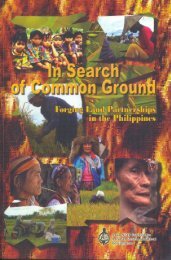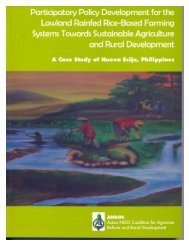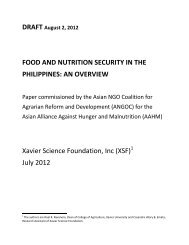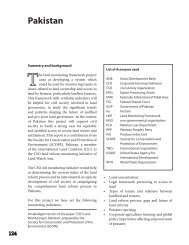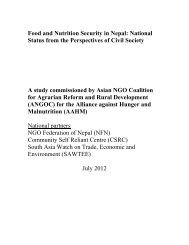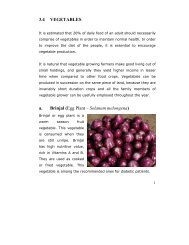Traditional Practices in Agriculture FULL - ANGOC Site
Traditional Practices in Agriculture FULL - ANGOC Site
Traditional Practices in Agriculture FULL - ANGOC Site
Create successful ePaper yourself
Turn your PDF publications into a flip-book with our unique Google optimized e-Paper software.
1. Grow<strong>in</strong>g tip is nipped to obta<strong>in</strong> fruits with more weight and<br />
size.<br />
2. Time of harvest is <strong>in</strong>dicated by the colour change at the base<br />
of fruits from green to yellow.<br />
h. Papaya (Carica papaya)<br />
It is a very common fruit<br />
that is consumed daily as<br />
that of banana. It is rich <strong>in</strong><br />
Vitam<strong>in</strong>s A and C. It cannot<br />
tolerate low temperature<br />
and comes up well under<br />
warm climate. Strong w<strong>in</strong>ds<br />
are highly detrimental to the<br />
crop as the hallow stems break easily. Occasional th<strong>in</strong>n<strong>in</strong>g of fruits<br />
is necessary to prevent over crowd<strong>in</strong>g. Low grow<strong>in</strong>g vegetables can<br />
be grown as <strong>in</strong>tercrops <strong>in</strong> papaya. Papaya itself can be grown as a<br />
filler crop <strong>in</strong> plantations of other crops where the spac<strong>in</strong>g is wide<br />
enough.<br />
Papaya is not a hermaphrodite and the plant is unisexual. Male<br />
plants do not bear any fruit and the function of the male flower is<br />
only poll<strong>in</strong>ation. Therefore, <strong>in</strong> papaya gardens it is necessary to<br />
have one male plant for every 12-15 female papaya plant.<br />
******<br />
11




